Multimodal Spatio-Temporal Data Visualization Technologies for Contemporary Urban Landscape Architecture: A Review and Prospect in the Context of Smart Cities
Abstract
1. Introduction
- What are the types of multimodal spatio-temporal data in landscape architecture, and how can they be used in corresponding visualization tasks?
- What are the application scenarios of multimodal spatio-temporal data visualization techniques in landscape architecture?
- What are the challenges and future directions faced by multimodal spatio-temporal data visualization techniques?
2. Materials and Methods
2.1. Data Collecting and Data Selection
2.2. Data Analysis and Synthesis
3. Current Research Status
3.1. Bibliometric Analysis
3.2. Data Types and Modalities
3.3. Visualization Application Scenarios
4. Application Scenarios in Landscape Research
4.1. Visual Representation of Multimodal Data
4.1.1. Traditional Spatial Distributions of Spatio-Temporal Data
4.1.2. Information Refinement for Massive Data
4.1.3. Multimodal Data Fusion in the New Data Environment
4.2. Visualization Analysis Methods Driven by Research Tasks
4.2.1. Spatial Pattern Analysis Based on Clustering
4.2.2. Mechanism Mining Based on Correlation Analysis
4.2.3. Real-Time Response Based on Process Simulation
4.2.4. Trend Judgment Based on Evolution Prediction
4.3. Visualization Interactive Platforms Oriented to Smart Cities
4.3.1. Scene Reconstruction of Multimodal Spatio-Temporal Data
4.3.2. Immersive Interaction for Decision-Making
5. Challenges and Future Directions
5.1. Research Challenges
- The integration and processing of data related issues
- 2.
- Task-driven visualization analysis related issues
- 3.
- The construction of visual interactive platform-related issues
5.2. Future Directions
- Real-time data presentation and dynamic interaction of multimodal data
- 2.
- Efficient integration and customization of visualization platforms
- 3.
- Intelligent data processing and immersive scene mapping
- 4.
- Multidisciplinary collaboration and case-driven practices
6. Conclusions
Author Contributions
Funding
Data Availability Statement
Conflicts of Interest
References
- Stratigea, A. The Concept of ‘Smart Cities’. Towards Community Development? Netcom Réseaux Commun. Territ. 2012, 26-3/4, 375–388. [Google Scholar] [CrossRef]
- Camero, A.; Alba, E. Smart City and Information Technology: A Review. Cities 2019, 93, 84–94. [Google Scholar] [CrossRef]
- Mora, L.; Bolici, R. How to Become a Smart City: Learning from Amsterdam. In Proceedings of the International Conference on Smart and Sustainable Planning for Cities and Regions; Springer International Publishing: Cham, Switzerland, 2015; pp. 251–266. [Google Scholar]
- Al-Azzawi, A. Dubai Happiness Agenda: Engineering the Happiest City on Earth. In Smart Cities in the Gulf: Current State, Opportunities, and Challenges; Springer: Singapore, 2018; pp. 195–221. [Google Scholar]
- de Hoop, E.; Smith, A.; Boon, W.; Macrorie, R.; Marvin, S.; Raven, R. Smart Urbanism in Barcelona: A Knowledge-Politics Perspective. In The Politics of Urban Sustainability Transitions; Routledge: London, UK, 2018; pp. 33–52. [Google Scholar]
- Griffiths, S.; Sovacool, B.K. Rethinking the Future Low-Carbon City: Carbon Neutrality, Green Design, and Sustainability Tensions in the Making of Masdar City. Energy Res. Soc. Sci. 2020, 62, 101368. [Google Scholar] [CrossRef]
- Lee, J.-G.; Kang, M. Geospatial Big Data: Challenges and Opportunities. Big Data Res. 2015, 2, 74–81. [Google Scholar] [CrossRef]
- Gandomi, A.; Haider, M. Beyond the Hype: Big Data Concepts, Methods, and Analytics. Int. J. Inf. Manag. 2015, 35, 137–144. [Google Scholar] [CrossRef]
- Kitchin, R. The Timescape of Smart Cities. Ann. Am. Assoc. Geogr. 2019, 109, 775–790. [Google Scholar] [CrossRef]
- Gill, L.; Lange, E.; Morgan, E.; Romano, D. An Analysis of Usage of Different Types of Visualisation Media within a Collaborative Planning Workshop Environment. Environ. Plan. B Plan. Des. 2013, 40, 742–754. [Google Scholar] [CrossRef]
- Raaphorst, K.; Duchhart, I.; Van Der Knaap, W.; Roeleveld, G.; Van Den Brink, A. The Semiotics of Landscape Design Communication: Towards a Critical Visual Research Approach in Landscape Architecture. Landsc. Res. 2017, 42, 120–133. [Google Scholar] [CrossRef]
- Van Den Brink, A.; Bruns, D. Strategies for Enhancing Landscape Architecture Research. Landsc. Res. 2014, 39, 7–20. [Google Scholar] [CrossRef]
- Mertens, E. Visualizing Landscape Architecture: Functions, Concepts, Strategies; DE GRUYTER: Berlin, Germany, 2010; ISBN 978-3-7643-8789-1. [Google Scholar]
- Pettit, C.J.; Raymond, C.M.; Bryan, B.A.; Lewis, H. Identifying Strengths and Weaknesses of Landscape Visualisation for Effective Communication of Future Alternatives. Landsc. Urban Plan. 2011, 100, 231–241. [Google Scholar] [CrossRef]
- Brückner, I.; Remy, M. BIM Model Landscape_open Spaces: An Approach for Landscape and Environmental Planning in Infrastructure Projects. J. Digit. Landsc. Archit. 2021, 6, 344–352. [Google Scholar]
- Jiang, L.; Masullo, M.; Maffei, L.; Meng, F.; Vorländer, M. A Demonstrator Tool of Web-Based Virtual Reality for Participatory Evaluation of Urban Sound Environment. Landsc. Urban Plan. 2018, 170, 276–282. [Google Scholar] [CrossRef]
- Sacchelli, S.; Favaro, M. A Virtual-Reality and Soundscape-Based Approach for Assessment and Management of Cultural Ecosystem Services in Urban Forest. Forests 2019, 10, 731. [Google Scholar] [CrossRef]
- Wang, Z.; Yu, L.; Yang, L. Rethinking the Application Research of Big Data in Chinese Landscape Architecture: Based on the Analysis of Relevant Literature from 2011 to 2021. Landsc. Archit. Acad. J. 2022, 39, 82–88. [Google Scholar]
- Wu, J. The Fourth Paradigm: A Research for the Predictive Model of Livability Based on Machine Learning for Smart City in The Netherlands. Landsc. Archit. 2020, 27, 11–29. [Google Scholar] [CrossRef]
- Yang, J.; Xiong, W.; Shen, Y.; Zhu, X. Eight Methods of Landscape Design: Exploration of Landscape Urban Design Based on Digital Information Map—Taking Hangzhou Qiantang River Area as an Example. Chin. Landsc. Archit. 2020, 36, 47–52. [Google Scholar] [CrossRef]
- Wang, Z.; Zhao, J.; Peng, Y.; Yue, W. Comparative Evaluation of Guangzhou City Parks: Text Analysis Based on Social Media Data. Landsc. Archit. 2019, 26, 89–94. [Google Scholar] [CrossRef]
- Dang, A.; Zhang, D.; Ma, Q.; Li, J. Study on Smart National Park Management and Service in the Big Data Era. J. Hum. Settl. West China 2016, 31, 8–13. [Google Scholar] [CrossRef]
- Nasr-Azadani, E.; Wardrop, D.; Brooks, R. Is the Rapid Development of Visualization Techniques Enhancing the Quality of Public Participation in Natural Resource Policy and Management? A Systematic Review. Landsc. Urban Plan. 2022, 228, 104586. [Google Scholar] [CrossRef]
- Hollberg, A.; Kiss, B.; Röck, M.; Soust-Verdaguer, B.; Wiberg, A.H.; Lasvaux, S.; Galimshina, A.; Habert, G. Review of Visualising LCA Results in the Design Process of Buildings. Build. Environ. 2021, 190, 107530. [Google Scholar] [CrossRef]
- Eilola, S.; Jaalama, K.; Kangassalo, P.; Nummi, P.; Staffans, A.; Fagerholm, N. 3D Visualisations for Communicative Urban and Landscape Planning: What Systematic Mapping of Academic Literature Can Tell Us of Their Potential? Landsc. Urban Plan. 2023, 234, 104716. [Google Scholar] [CrossRef]
- Miranda, F.; Ortner, T.; Moreira, G.; Hosseini, M.; Vuckovic, M.; Biljecki, F.; Silva, C.T.; Lage, M.; Ferreira, N. The State of the Art in Visual Analytics for 3D Urban Data. Comput. Graph. Forum 2024, 43, e15112. [Google Scholar] [CrossRef]
- Daudt, H.M.; Van Mossel, C.; Scott, S.J. Enhancing the Scoping Study Methodology: A Large, Inter-Professional Team’s Experience with Arksey and O’Malley’s Framework. BMC Med. Res. Methodol. 2013, 13, 48. [Google Scholar] [CrossRef] [PubMed]
- Arksey, H.; O’malley, L. Scoping Studies: Towards a Methodological Framework. Int. J. Soc. Res. Methodol. 2005, 8, 19–32. [Google Scholar] [CrossRef]
- Peters, M.D.; Godfrey, C.M.; Khalil, H.; McInerney, P.; Parker, D.; Soares, C.B. Guidance for Conducting Systematic Scoping Reviews. JBI Evid. Implement. 2015, 13, 141–146. [Google Scholar] [CrossRef]
- Munn, Z.; Peters, M.D.; Stern, C.; Tufanaru, C.; McArthur, A.; Aromataris, E. Systematic Review or Scoping Review? Guidance for Authors When Choosing between a Systematic or Scoping Review Approach. BMC Med. Res. Methodol. 2018, 18, 143. [Google Scholar] [CrossRef]
- Levac, D.; Colquhoun, H.; O’Brien, K.K. Scoping Studies: Advancing the Methodology. Implement. Sci. 2010, 5, 69. [Google Scholar] [CrossRef]
- Grant, M.J.; Booth, A. A Typology of Reviews: An Analysis of 14 Review Types and Associated Methodologies. Health Inf. Libr. J. 2009, 26, 91–108. [Google Scholar] [CrossRef] [PubMed]
- Petticrew, M.; Roberts, H. Systematic Reviews in the Social Sciences: A Practical Guide; Blackwell Publishing: Malden, MA, USA, 2006; ISBN 1-4051-2110-6. [Google Scholar]
- Lahat, D.; Adali, T.; Jutten, C. Multimodal Data Fusion: An Overview of Methods, Challenges, and Prospects. Proc. IEEE 2015, 103, 1449–1477. [Google Scholar] [CrossRef]
- Laney, D. 3D Data Management: Controlling Data Volume, Velocity and Variety. META Group Research Note, 2001, 6, 1. Available online: https://www.scirp.org/reference/ReferencesPapers?ReferenceID=1611280 (accessed on 8 April 2025).
- Chen, H.; Chiang, R.H.; Storey, V.C. Business Intelligence and Analytics: From Big Data to Big Impact. MIS Q. 2012, 36, 1165. [Google Scholar] [CrossRef]
- Kitchin, R.; McArdle, G. What Makes Big Data, Big Data? Exploring the Ontological Characteristics of 26 Datasets. Big Data Soc. 2016, 3, 2053951716631130. [Google Scholar] [CrossRef]
- Longley, P.A. Geographical Information Systems: Will Developments in Urban Remote Sensing and GIS Lead to ‘Better’ Urban Geography? Prog. Hum. Geogr. 2002, 26, 231–239. [Google Scholar] [CrossRef]
- Hu, S.; Wang, L. Automated Urban Land-Use Classification with Remote Sensing. Int. J. Remote Sens. 2013, 34, 790–803. [Google Scholar] [CrossRef]
- Nebiker, S.; Bleisch, S.; Christen, M. Rich Point Clouds in Virtual Globes—A New Paradigm in City Modeling? Comput. Environ. Urban Syst. 2010, 34, 508–517. [Google Scholar] [CrossRef]
- Tateosian, L.; Mitasova, H.; Thakur, S.; Hardin, E.; Russ, E.; Blundell, B. Visualizations of Coastal Terrain Time Series. Inf. Vis. 2014, 13, 266–282. [Google Scholar] [CrossRef]
- McEntee, J.; Agyeman, J. Towards the Development of a GIS Method for Identifying Rural Food Deserts: Geographic Access in Vermont, USA. Appl. Geogr. 2010, 30, 165–176. [Google Scholar] [CrossRef]
- Buyantuyev, A.; Wu, J.; Gries, C. Multiscale Analysis of the Urbanization Pattern of the Phoenix Metropolitan Landscape of USA: Time, Space and Thematic Resolution. Landsc. Urban Plan. 2010, 94, 206–217. [Google Scholar] [CrossRef]
- Nikolaishvili, D.A.; Elizbarashvili, N.K.; Meladze, G.G. Evaluation of Degree of Landscape’s Anthropogenic Transformation (Landscapes of Georgia). Procedia-Soc. Behav. Sci. 2011, 19, 547–555. [Google Scholar] [CrossRef]
- Wu, R.; Wang, J.; Zhang, D.; Wang, S. Identifying Different Types of Urban Land Use Dynamics Using Point-of-Interest (POI) and Random Forest Algorithm: The Case of Huizhou, China. Cities 2021, 114, 103202. [Google Scholar] [CrossRef]
- Li, S.; Ma, H.; Yang, D.; Hu, W.; Li, H. The Main Drivers of Wetland Evolution in the Beijing-Tianjin-Hebei Plain. Land 2023, 12, 480. [Google Scholar] [CrossRef]
- Chen, Y.; Jing, Q.; Xiao, L.; Ding, Y.; Hu, M.; Che, W.; Lin, H. A Multi-Level Situational Awareness Method with Dynamic Multi-Modal Data Visualization for Air Pollution Monitoring. In Proceedings of the IGARSS 2022-2022 IEEE International Geoscience and Remote Sensing Symposium, IEEE, Kuala Lumpur, Malaysia, 17 July 2022; pp. 489–492. [Google Scholar]
- Elvidge, C.D.; Cinzano, P.; Pettit, D.R.; Arvesen, J.; Sutton, P.; Small, C.; Nemani, R.; Longcore, T.; Rich, C.; Safran, J. The Nightsat Mission Concept. Int. J. Remote Sens. 2007, 28, 2645–2670. [Google Scholar] [CrossRef]
- Zhang, B.; Zhong, C.; Gao, Q.; Shabrina, Z.; Tu, W. Delineating Urban Functional Zones Using Mobile Phone Data: A Case Study of Cross-Boundary Integration in Shenzhen-Dongguan-Huizhou Area. Comput. Environ. Urban Syst. 2022, 98, 101872. [Google Scholar] [CrossRef]
- Alamri, S. Independent Map Enhancement for a Spatial Road Network: Fundamental Applications and Opportunities. ISPRS Int. J. Geo-Inf. 2020, 10, 8. [Google Scholar] [CrossRef]
- Crooks, A.; Pfoser, D.; Jenkins, A.; Croitoru, A.; Stefanidis, A.; Smith, D.; Karagiorgou, S.; Efentakis, A.; Lamprianidis, G. Crowdsourcing Urban Form and Function. Int. J. Geogr. Inf. Sci. 2015, 29, 720–741. [Google Scholar] [CrossRef]
- Ciuccarelli, P.; Lupi, G.; Simeone, L. Visualizing the Data City: Social Media as a Source of Knowledge for Urban Planning and Management; SpringerBriefs in Applied Sciences and Technology; Springer International Publishing: Cham, Switzerland, 2014; ISBN 978-3-319-02194-2. [Google Scholar]
- Theobald, D.M. Topology Revisited: Representing Spatial Relations. Int. J. Geogr. Inf. Sci. 2001, 15, 689–705. [Google Scholar] [CrossRef]
- Sang, N.; Gold, C.; Miller, D. The Topological Viewshed: Embedding Topological Pointers into Digital Terrain Models to Improve GIS Capability for Visual Landscape Analysis. Int. J. Digit. Earth 2016, 9, 1185–1205. [Google Scholar] [CrossRef]
- Wei, Y.; Liu, H.; Song, W.; Yu, B.; Xiu, C. Normalization of Time Series DMSP-OLS Nighttime Light Images for Urban Growth Analysis with Pseudo Invariant Features. Landsc. Urban Plan. 2014, 128, 1–13. [Google Scholar] [CrossRef]
- Mennis, J.; Liu, J.W. Mining Association Rules in Spatio-Temporal Data: An Analysis of Urban Socioeconomic and Land Cover Change. Trans. GIS 2005, 9, 5–17. [Google Scholar] [CrossRef]
- Kamel, M.B.; Sayed, T. The Impact of Bike Network Indicators on Bike Kilometers Traveled and Bike Safety: A Network Theory Approach. Environ. Plan. B 2021, 48, 2055–2072. [Google Scholar] [CrossRef]
- Beck, B.; Pettit, C.; Winters, M.; Nelson, T.; Vu, H.L.; Nice, K.; Seneviratne, S.; Saberi, M. Association between Network Characteristics and Bicycle Ridership across a Large Metropolitan Region. Int. J. Sustain. Transp. 2024, 18, 344–355. [Google Scholar] [CrossRef]
- Masud, L.; Valsecchi, F.; Ciuccarelli, P.; Ricci, D.; Caviglia, G. From Data to Knowledge-Visualizations as Transformation Processes within the Data-Information-Knowledge Continuum. In Proceedings of the 2010 14th International Conference Information Visualisation, IEEE, London, UK, 26–29 July 2010; pp. 445–449. [Google Scholar]
- Zeng, W.; Fu, C.-W.; Muller Arisona, S.; Schubiger, S.; Burkhard, R.; Ma, K.-L. Visualizing the Relationship Between Human Mobility and Points of Interest. IEEE Trans. Intell. Transp. Syst. 2017, 18, 2271–2284. [Google Scholar] [CrossRef]
- Pan, J. Area Delineation and Spatial-Temporal Dynamics of Urban Heat Island in Lanzhou City, China Using Remote Sensing Imagery. J. Indian Soc. Remote Sens. 2016, 44, 111–127. [Google Scholar] [CrossRef]
- De Bie, C.A.J.M.; Nguyen, T.T.H.; Ali, A.; Scarrott, R.; Skidmore, A.K. LaHMa: A Landscape Heterogeneity Mapping Method Using Hyper-Temporal Datasets. Int. J. Geogr. Inf. Sci. 2012, 26, 2177–2192. [Google Scholar] [CrossRef]
- Liu, F.; Andrienko, G.; Andrienko, N.; Chen, S.; Janssens, D.; Wets, G.; Theodoridis, Y. Citywide Traffic Analysis Based on the Combination of Visual and Analytic Approaches. J. Geovisualization Spat. Anal. 2020, 4, 15. [Google Scholar] [CrossRef]
- Zhong, C.; Wang, C.; Li, H.; Chen, W.; Hou, Y. Mapping Inter-Annual Land Cover Variations Automatically Based on a Novel Sample Transfer Method. Remote Sens. 2018, 10, 1457. [Google Scholar] [CrossRef]
- Liu, C.; Zhang, Q.; Luo, H.; Qi, S.; Tao, S.; Xu, H.; Yao, Y. An Efficient Approach to Capture Continuous Impervious Surface Dynamics Using Spatial-Temporal Rules and Dense Landsat Time Series Stacks. Remote Sens. Environ. 2019, 229, 114–132. [Google Scholar] [CrossRef]
- Zhang, T.; He, W.; Huang, J.; He, Z.; Li, J. Interactive Visual Analytics of Moving Passenger Flocks Using Massive Smart Card Data. Cartogr. Geogr. Inf. Sci. 2022, 49, 354–369. [Google Scholar] [CrossRef]
- Hartigan, J.A.; Wong, M.A. Algorithm AS 136: A K-Means Clustering Algorithm. Appl. Stat. 1979, 28, 100. [Google Scholar] [CrossRef]
- Tieskens, K.F.; Schulp, C.J.E.; Levers, C.; Lieskovský, J.; Kuemmerle, T.; Plieninger, T.; Verburg, P.H. Characterizing European Cultural Landscapes: Accounting for Structure, Management Intensity and Value of Agricultural and Forest Landscapes. Land Use Policy 2017, 62, 29–39. [Google Scholar] [CrossRef]
- Kieu, L.-M.; Bhaskar, A.; Chung, E. A Modified Density-Based Scanning Algorithm with Noise for Spatial Travel Pattern Analysis from Smart Card AFC Data. Transp. Res. Part C Emerg. Technol. 2015, 58, 193–207. [Google Scholar] [CrossRef]
- Yu, C.; He, Z.-C. Analysing the Spatial-Temporal Characteristics of Bus Travel Demand Using the Heat Map. J. Transp. Geogr. 2017, 58, 247–255. [Google Scholar] [CrossRef]
- Zhang, T.; Li, Y.; Yang, H.; Cui, C.; Li, J.; Qiao, Q. Identifying Primary Public Transit Corridors Using Multi-Source Big Transit Data. Int. J. Geogr. Inf. Sci. 2020, 34, 1137–1161. [Google Scholar] [CrossRef]
- Li, S.; Han, B.; Zhang, X.; Li, T.; Zheng, Y. Interactive visualization method of multi-category urban spatiotemporal big data based on point aggregation. J. Comput. Appl. 2025, 1–9. [Google Scholar] [CrossRef]
- Wang, J.; Wu, F.; Guo, J.; Cheng, Y.; Chen, K. Challenges and opportunities of spatio-temporal big data. Sci. Surv. Mapp. 2017, 42, 1–7. [Google Scholar] [CrossRef]
- Wang, C.; Tao, J. Graphs in Scientific Visualization: A Survey. Comput. Graph. Forum 2017, 36, 263–287. [Google Scholar] [CrossRef]
- Inselberg, A. The Plane with Parallel Coordinates. Vis. Comput. 1985, 1, 69–91. [Google Scholar] [CrossRef]
- Itoh, T.; Kumar, A.; Klein, K.; Kim, J. High-Dimensional Data Visualization by Interactive Construction of Low-Dimensional Parallel Coordinate Plots. J. Vis. Lang. Comput. 2017, 43, 1–13. [Google Scholar] [CrossRef]
- Yuan, Y.; Tan, F.; Fan, B.; Cheng, Y. Research on the Construction of Full-elements Digital Model of Rural Landscape: A Case Study of Changkou Village in Jiangle County, Fujian Province. Chin. Landsc. Archit. 2023, 39, 50–56. [Google Scholar] [CrossRef]
- Fang, Z.; Li, Q.; Zhang, X.; Shaw, S.-L. A GIS Data Model for Landmark-Based Pedestrian Navigation. Int. J. Geogr. Inf. Sci. 2012, 26, 817–838. [Google Scholar] [CrossRef]
- Zhou, X.; Zhang, L. Crowdsourcing Functions of the Living City from Twitter and Foursquare Data. Cartogr. Geogr. Inf. Sci. 2016, 43, 393–404. [Google Scholar] [CrossRef]
- Srivastava, S.; Vargas-Muñoz, J.E.; Tuia, D. Understanding Urban Landuse from the above and Ground Perspectives: A Deep Learning, Multimodal Solution. Remote Sens. Environ. 2019, 228, 129–143. [Google Scholar] [CrossRef]
- Crivellari, A.; Resch, B. Investigating Functional Consistency of Mobility-Related Urban Zones via Motion-Driven Embedding Vectors and Local POI-Type Distributions. Comput. Urban Sci. 2022, 2, 19. [Google Scholar] [CrossRef]
- Song, J.; Fan, H.; Gao, M.; Xu, Y.; Ran, M.; Liu, X.; Guo, Y. Toward High-Performance Map-Recovery of Air Pollution Using Machine Learning. ACS EST Eng. 2023, 3, 73–85. [Google Scholar] [CrossRef]
- Zhang, Z.; Vosselman, G.; Gerke, M.; Persello, C.; Tuia, D.; Yang, M.Y. Detecting Building Changes between Airborne Laser Scanning and Photogrammetric Data. Remote Sens. 2019, 11, 2417. [Google Scholar] [CrossRef]
- Wong, P.-Y.; Su, H.-J.; Lee, H.-Y.; Chen, Y.-C.; Hsiao, Y.-P.; Huang, J.-W.; Teo, T.-A.; Wu, C.-D.; Spengler, J.D. Using Land-Use Machine Learning Models to Estimate Daily NO2 Concentration Variations in Taiwan. J. Clean. Prod. 2021, 317, 128411. [Google Scholar] [CrossRef]
- Wu, H.; Li, Y.; Lin, A.; Fan, H.; Fan, K.; Xie, J.; Luo, W. A Review of Crowdsourced Geographic Information for Land-Use and Land-Cover Mapping: Current Progress and Challenges. Int. J. Geogr. Inf. Sci. 2024, 38, 2183–2215. [Google Scholar] [CrossRef]
- Zielstra, D.; Hochmair, H.H. Positional Accuracy Analysis of Flickr and Panoramio Images for Selected World Regions. J. Spat. Sci. 2013, 58, 251–273. [Google Scholar] [CrossRef]
- Barrington-Leigh, C.; Millard-Ball, A. The World’s User-Generated Road Map Is More than 80% Complete. PLoS ONE 2017, 12, e0180698. [Google Scholar] [CrossRef]
- Gillespie, L.E.; Ruffley, M.; Exposito-Alonso, M. Deep Learning Models Map Rapid Plant Species Changes from Citizen Science and Remote Sensing Data. Proc. Natl. Acad. Sci. USA 2024, 121, e2318296121. [Google Scholar] [CrossRef]
- Wilkie, S.; Thompson, E.; Cranner, P.; Ginty, K. Attention Restoration Theory as a Framework for Analysis of Tweets about Urban Green Space: A Case Study. Landsc. Res. 2020, 45, 777–788. [Google Scholar] [CrossRef]
- Antoniou, V.; Skopeliti, A. Measures and Indicators of VGI quality: An Overview. ISPRS Ann. Photogramm. Remote Sens. Spat. Inf. Sci. 2015, II-3-W5, 345–351. [Google Scholar] [CrossRef]
- Senaratne, H.; Mobasheri, A.; Ali, A.L.; Capineri, C.; Haklay, M. A Review of Volunteered Geographic Information Quality Assessment Methods. Int. J. Geogr. Inf. Sci. 2017, 31, 139–167. [Google Scholar] [CrossRef]
- ISO 19113: 2002; Geographic Information—Quality Principles; ISO/TC211. International Organization for Standardization: Geneva, Switzerland, 2002.
- Chen, D.; Tu, W.; Cao, R.; Zhang, Y.; He, B.; Wang, C.; Shi, T.; Li, Q. A Hierarchical Approach for Fine-Grained Urban Villages Recognition Fusing Remote and Social Sensing Data. Int. J. Appl. Earth Obs. Geoinf. 2022, 106, 102661. [Google Scholar] [CrossRef]
- Comber, A.; Mooney, P.; Purves, R.S.; Rocchini, D.; Walz, A. Crowdsourcing: It Matters Who the Crowd Are. The Impacts of between Group Variations in Recording Land Cover. PLoS ONE 2016, 11, e0158329. [Google Scholar] [CrossRef] [PubMed]
- Maimon, O.; Rokach, L. (Eds.) Data Mining and Knowledge Discovery Handbook; Springer: New York, NY, USA, 2005; ISBN 978-0-387-24435-8. [Google Scholar]
- Tao, S.; Rohde, D.; Corcoran, J. Examining the Spatial–Temporal Dynamics of Bus Passenger Travel Behaviour Using Smart Card Data and the Flow-Comap. J. Transp. Geogr. 2014, 41, 21–36. [Google Scholar] [CrossRef]
- Yu, W.; Ai, T.; He, Y.; Shao, S. Spatial Co-Location Pattern Mining of Facility Points-of-Interest Improved by Network Neighborhood and Distance Decay Effects. Int. J. Geogr. Inf. Sci. 2017, 31, 280–296. [Google Scholar] [CrossRef]
- Tang, J.; Liu, Q.; Deng, M.; Huang, J.; Cai, J. A Permutation Test for Identifying Significant Clusters in Spatial Dataset. Acta Geod. Cartogr. Sin. 2016, 45, 233–240. [Google Scholar]
- Li, Z.; Lu, X.; Shi, J.; Huang, R.; Gao, Y. Quantitative Research of Landscape Texture for Polders in Xuanwu Plain Based on Morphological Index: A Case Study of Yongfeng Polder. Chin. Landsc. Archit. 2023, 39, 41–46. [Google Scholar] [CrossRef]
- Chen, Y.; Liu, X.; Li, X.; Liu, X.; Yao, Y.; Hu, G.; Xu, X.; Pei, F. Delineating Urban Functional Areas with Building-Level Social Media Data: A Dynamic Time Warping (DTW) Distance Based k -Medoids Method. Landsc. Urban Plan. 2017, 160, 48–60. [Google Scholar] [CrossRef]
- Qin, X.; Zhen, F. Combination Between Big Data and Small Data: New Methods of Urban Studies in The Information Era. Sci. Geogr. Sin. 2017, 37, 321–330. [Google Scholar] [CrossRef]
- Cui, C.; Wu, X.; Liu, L.; Zhang, W. The Spatial-Temporal Dynamics of Daily Intercity Mobility in the Yangtze River Delta: An Analysis Using Big Data. Habitat Int. 2020, 106, 102174. [Google Scholar] [CrossRef]
- Afzal, S.; Hittawe, M.M.; Ghani, S.; Jamil, T.; Knio, O.; Hadwiger, M.; Hoteit, I. The State of the Art in Visual Analysis Approaches for Ocean and Atmospheric Datasets. Comput. Graph. Forum 2019, 38, 881–907. [Google Scholar] [CrossRef]
- Fotheringham, A.S.; Brunsdon, C.; Charlton, M. Quantitative Geography: Perspectives on Spatial Data Analysis; SAGE Publications Ltd.: London, UK, 2000; ISBN 0-7619-5948-3. [Google Scholar]
- Haining, R.P. Spatial Data Analysis: Theory and Practice; Cambridge University Press: Cambridge, UK, 2003; ISBN 0-521-77437-3. [Google Scholar]
- Wang, J.; Xu, C. Geodetector: Principle and prospective. Acta Geogr. Sin. 2017, 72, 116–134. [Google Scholar] [CrossRef]
- Obeso Muñiz, Í. The Spatial Diffusion of Economic Activity in the Oviedo Region (1970–2018). Investig. Geográficas 2019, 72, 189–207. [Google Scholar] [CrossRef]
- Liu, Z.; Wang, F.; Xue, P.; Xue, F. Using Multi-Layer Nested Network to Optimise Spatial Structure of Tourism Development between Urban and Rural Areas Based on Population Mobility. Indoor Built Environ. 2022, 31, 1028–1046. [Google Scholar] [CrossRef]
- Anselin, L. Spatial Econometrics: Methods and Models; Studies in Operational Regional Science; Springer: Dordrecht, The Netherlands, 1988; Volume 4, ISBN 978-90-481-8311-1. [Google Scholar]
- Jin, Z.; Wei, L. From Flood Land to New Urban Area: Water Adaptation History and Visions for Daodi Flood Land in the West of Beijing. Landsc. Archit. Front. 2021, 9, 50. [Google Scholar] [CrossRef]
- Novotný, M.; Skaloš, J.; Plieninger, T. Spatial-Temporal Changes in Trees Outside Forests: Case Study from the Czech Republic 1953–2014. Appl. Geogr. 2017, 87, 139–148. [Google Scholar] [CrossRef]
- Xie, M.; Dong, Z.; Cheng, Y. A Comprehensive Study of Research Frameworks, Key Technologies and Practice Cases for Sponge City Planning Based on Digital Landscape Architecture: From Hydrological Analysis to Intelligent Monitoring and Control. Chin. Landsc. Archit. 2023, 39, 48–54. [Google Scholar] [CrossRef]
- Zeng, Z.; Yuan, X.; Liang, J.; Li, Y. Designing and Implementing an SWMM-Based Web Service Framework to Provide Decision Support for Real-Time Urban Stormwater Management. Environ. Model. Softw. 2021, 135, 104887. [Google Scholar] [CrossRef]
- Anjomshoaa, A.; Duarte, F.; Rennings, D.; Matarazzo, T.J.; deSouza, P.; Ratti, C. City Scanner: Building and Scheduling a Mobile Sensing Platform for Smart City Services. IEEE Internet Things J. 2018, 5, 4567–4579. [Google Scholar] [CrossRef]
- Cheng, Y.; Xie, M. Being both Opposite and Complementary: Urban Road Sponge System Practice Based on Digital Technology—Taking Nanjing Tianbao Street Ecological Road as the Example. Chin. Landsc. Archit. 2017, 33, 5–13. [Google Scholar]
- Chen, Y.; Han, D. Water Quality Monitoring in Smart City: A Pilot Project. Autom. Constr. 2018, 89, 307–316. [Google Scholar] [CrossRef]
- Cao, G.; Wang, S.; Hwang, M.; Padmanabhan, A.; Zhang, Z.; Soltani, K. A Scalable Framework for Spatiotemporal Analysis of Location-Based Social Media Data. Comput. Environ. Urban Syst. 2015, 51, 70–82. [Google Scholar] [CrossRef]
- Shen, Y. Synergised City: Frequency Synergy in Spatiotemporal Data-Augmented-Design. Shanghai Urban Plan. Rev. 2022, 3, 8–13. [Google Scholar] [CrossRef]
- Mahomed, A.S.; Saha, A.K. Unleashing the Potential of 5G for Smart Cities: A Focus on Real-Time Digital Twin Integration. Smart Cities 2025, 8, 70. [Google Scholar] [CrossRef]
- Shi, W.; Zhang, A. Introduction to Urban Computing. In Urban Informatics; Shi, W., Goodchild, M.F., Batty, M., Kwan, M.-P., Zhang, A., Eds.; Springer: Singapore, 2021; ISBN 978-981-15-8983-6. [Google Scholar]
- Batty, M. Visualizing Aggregate Movement in Cities. Philos. Trans. R. Soc. B Biol. Sci. 2018, 373, 20170236. [Google Scholar] [CrossRef] [PubMed]
- Cureau, R.J.; Balocco, C.; Pigliautile, I.; Piselli, C.; Fabiani, C.; Cotana, F.; Carletti, C.; Sciurpi, F.; Pisello, A.L. On Urban Microclimate Spatial-Temporal Dynamics: Evidence from the Integration of Fixed and Wearable Sensing and Mapping Techniques. Environ. Res. 2024, 262, 119795. [Google Scholar] [CrossRef] [PubMed]
- Hladík, J.; Snopková, D.; Lichter, M.; Herman, L.; Konečný, M. Spatial-Temporal Analysis of Retail and Services Using Facebook Places Data: A Case Study in Brno, Czech Republic. Ann. GIS 2022, 28, 127–145. [Google Scholar] [CrossRef]
- Fotheringham, A.; Rogerson, P.; Fotheringham, A.S. Geographically Weighted Regression. In The SAGE Handbook of Spatial Analysis; SAGE Publications Ltd: London, UK, 2009; pp. 243–254. [Google Scholar]
- Iranmanesh, M.; Seyedabrishami, S.; Moridpour, S. Identifying High Crash Risk Segments in Rural Roads Using Ensemble Decision Tree-Based Models. Sci. Rep. 2022, 12, 20024. [Google Scholar] [CrossRef]
- Xu, L.; Chen, N.; Chen, Z.; Zhang, C.; Yu, H. Spatiotemporal Forecasting in Earth System Science: Methods, Uncertainties, Predictability and Future Directions. Earth-Sci. Rev. 2021, 222, 103828. [Google Scholar] [CrossRef]
- Liu, Z.; Han, L.; Liu, M. High-Resolution Carbon Emission Mapping and Spatial-Temporal Analysis Based on Multi-Source Geographic Data: A Case Study in Xi’an City, China. Environ. Pollut. 2024, 361, 124879. [Google Scholar] [CrossRef] [PubMed]
- Wang, S.; Wang, L. A Novel Framework for Mapping Updated Fine-Resolution Populations with Remote Sensing and Mobile Phone Data. J. Remote Sens. 2024, 4, 0227. [Google Scholar] [CrossRef]
- Anderson, L.D. Applying Geographic Information Systems to Transportation Planning. Transp. Res. Rec. 1991, 1305, 113–117. [Google Scholar]
- Lovelace, R.; Birkin, M.; Cross, P.; Clarke, M. From Big Noise to Big Data: Toward the Verification of Large Data Sets for Understanding Regional Retail Flows. Geogr. Anal. 2016, 48, 59–81. [Google Scholar] [CrossRef]
- Loidl, M.; Wallentin, G.; Cyganski, R.; Graser, A.; Scholz, J.; Haslauer, E. GIS and Transport Modeling—Strengthening the Spatial Perspective. ISPRS Int. J. Geo-Inf. 2016, 5, 84. [Google Scholar] [CrossRef]
- Cheng, Y.; Fan, B. Digital Landscape Process. Chin. Landsc. Archit. 2023, 39, 6–12. [Google Scholar] [CrossRef]
- Liu, W.; Lv, Y.; Wang, Q.; Sun, B.; Han, D. A Systematic Review of the Digital Twin Technology in Buildings, Landscape and Urban Environment from 2018 to 2024. Buildings 2024, 14, 3475. [Google Scholar] [CrossRef]
- Tan, F.; Cheng, Y. A Digital Twin Framework for Innovating Rural Ecological Landscape Control. Environ. Sci. Eur. 2024, 36, 59. [Google Scholar] [CrossRef]
- Cureton, P.; Dunn, N. Digital Twins of Cities and Evasive Futures. In Shaping Smart for Better Cities; Elsevier: Amsterdam, The Netherlands, 2021; pp. 267–282. [Google Scholar]
- Huang, A.; Liu, Y.; Chen, T.; Zhou, Y.; Sun, Q.; Chai, H.; Yang, Q. Starfl: Hybrid Federated Learning Architecture for Smart Urban Computing. ACM Trans. Intell. Syst. Technol. TIST 2021, 12, 1–23. [Google Scholar] [CrossRef]
- Jia, M.; Komeily, A.; Wang, Y.; Srinivasan, R.S. Adopting Internet of Things for the Development of Smart Buildings: A Review of Enabling Technologies and Applications. Autom. Constr. 2019, 101, 111–126. [Google Scholar] [CrossRef]
- Shahzad, M.; Shafiq, M.T.; Douglas, D.; Kassem, M. Digital Twins in Built Environments: An Investigation of the Characteristics, Applications, and Challenges. Buildings 2022, 12, 120. [Google Scholar] [CrossRef]
- He, B.; Guo, R.; Zhang, C.; Ma, D.; Wang, W.; Hong, W.; Chen, Y. A natural scene construction method for digital twin cities. Bull. Surv. Mapp. 2022, 7, 87–92. [Google Scholar] [CrossRef]
- Tam, P.; Math, S.; Nam, C.; Kim, S. Adaptive Resource Optimized Edge Federated Learning in Real-Time Image Sensing Classifications. IEEE J. Sel. Top. Appl. Earth Obs. Remote Sens. 2021, 14, 10929–10940. [Google Scholar] [CrossRef]
- Fuller, A.; Fan, Z.; Day, C.; Barlow, C. Digital Twin: Enabling Technologies, Challenges and Open Research. IEEE Access 2020, 8, 108952–108971. [Google Scholar] [CrossRef]
- Zhu, A.-X.; Zhao, F.-H.; Liang, P.; Qin, C.-Z. Next Generation of GIS: Must Be Easy. Ann. GIS 2021, 27, 71–86. [Google Scholar] [CrossRef]
- Vandewalle, R.C.; Barley, W.C.; Padmanabhan, A.; Katz, D.S.; Wang, S. Understanding the Multifaceted Geospatial Software Ecosystem: A Survey Approach. Int. J. Geogr. Inf. Sci. 2021, 35, 2168–2186. [Google Scholar] [CrossRef]
- McIntire, J.P.; Havig, P.R.; Geiselman, E.E. Stereoscopic 3D Displays and Human Performance: A Comprehensive Review. Displays 2014, 35, 18–26. [Google Scholar] [CrossRef]
- Simpson, M.; Padilla, L.; Keller, K.; Klippel, A. Immersive Storm Surge Flooding: Scale and Risk Perception in Virtual Reality. J. Environ. Psychol. 2022, 80, 101764. [Google Scholar] [CrossRef]
- Tomkins, A.; Lange, E. Interactive Landscape Design and Flood Visualisation in Augmented Reality. Multimodal Technol. Interact. 2019, 3, 43. [Google Scholar] [CrossRef]
- Barba, E.; Marroquin, R.Z. A Primer on Spatial Scale and Its Application to Mixed Reality. In Proceedings of the 2017 IEEE International Symposium on Mixed and Augmented Reality (ISMAR), IEEE, Nantes, France, 9–13 October 2017; pp. 100–110. [Google Scholar]
- Afrooz, A.; Ding, L.; Pettit, C. An Immersive 3D Virtual Environment to Support Collaborative Learning and Teaching. In Computational Urban Planning and Management for Smart Cities; Geertman, S., Zhan, Q., Allan, A., Pettit, C., Eds.; Springer International Publishing: Cham, Switzerland, 2019; pp. 267–282. ISBN 978-3-030-19424-6. [Google Scholar]
- Luo, J.; Zhao, T.; Cao, L.; Biljecki, F. Water View Imagery: Perception and Evaluation of Urban Waterscapes Worldwide. Ecol. Indic. 2022, 145, 109615. [Google Scholar] [CrossRef]
- Lock, O.; Bednarz, T.; Pettit, C. HoloCity—Exploring the Use of Augmented Reality Cityscapes for Collaborative Understanding of High-Volume Urban Sensor Data. In Proceedings of the 17th ACM SIGGRAPH International Conference on Virtual-Reality Continuum and Its Applications in Industry, Brisbane, Australia, 14–16 November 2019; Association for Computing Machinery: New York, NY, USA, 2019; pp. 1–2. [Google Scholar]
- Russo, P.; Lanzilotti, R.; Costabile, M.F.; Pettit, C.J. Towards Satisfying Practitioners in Using Planning Support Systems. Comput. Environ. Urban Syst. 2018, 67, 9–20. [Google Scholar] [CrossRef]
- Liang, J.; Li, W.; Li, W.; Long, Y. Application Scenario and Practice Path of Urban Landscape Driven by Digital Technology. Landsc. Archit. 2023, 30, 29–35. [Google Scholar]
- Barricelli, B.R.; Casiraghi, E.; Fogli, D. A Survey on Digital Twin: Definitions, Characteristics, Applications, and Design Implications. IEEE Access 2019, 7, 167653–167671. [Google Scholar] [CrossRef]
- Ramu, S.P.; Boopalan, P.; Pham, Q.-V.; Maddikunta, P.K.R.; Huynh-The, T.; Alazab, M.; Nguyen, T.T.; Gadekallu, T.R. Federated Learning Enabled Digital Twins for Smart Cities: Concepts, Recent Advances, and Future Directions. Sustain. Cities Soc. 2022, 79, 103663. [Google Scholar] [CrossRef]
- Zhan, H.; Hwang, B.-G.; Zhu, H.; Ang, S.H.P. Towards a Sustainable Built Environment Industry in Singapore: Drivers, Barriers, and Strategies in the Adoption of Smart Facilities Management. J. Clean. Prod. 2023, 425, 138726. [Google Scholar] [CrossRef]
- Fekete, T.; Mengistu, G.; Wicaksono, H. Leveraging Causal AI to Uncover the Dynamics in Sustainable Urban Transport: A Bike Sharing Time-Series Study. Sustain. Cities Soc. 2025, 122, 106240. [Google Scholar] [CrossRef]
- Çöltekin, A.; Lokka, I.; Zahner, M.; Halounova, L. On the Usability and Usefulness of 3D (Geo) Visualizations—A Focus on Virtual Reality Environments. In Proceedings of the International Archives of the Photogrammetry, Remote Sensing and Spatial Information Sciences, Volume XLI-B2, 2016 XXIII ISPRS Congress, Prague, Czech Republic, 12–19 July 2016. [Google Scholar]
- Çöltekin, A.; Lochhead, I.; Madden, M.; Christophe, S.; Devaux, A.; Pettit, C.; Lock, O.; Shukla, S.; Herman, L.; Stachoň, Z.; et al. Extended Reality in Spatial Sciences: A Review of Research Challenges and Future Directions. ISPRS Int. J. Geo-Inf. 2020, 9, 439. [Google Scholar] [CrossRef]
- Barns, S. Smart Cities and Urban Data Platforms: Designing Interfaces for Smart Governance. City Cult. Soc. 2018, 12, 5–12. [Google Scholar] [CrossRef]
- Bertin, J. Semiology of Graphics; University of Wisconsin Press: Madison, WI, USA, 1983; ISBN 0-299-09060-4. [Google Scholar]
- Munzner, T. Visualization Analysis and Design; CRC Press: Boca Raton, FL, USA, 2014; ISBN 1-4987-5971-8. [Google Scholar]
- Donderi, D.C. Visual Complexity: A Review. Psychol. Bull. 2006, 132, 73. [Google Scholar] [CrossRef]
- Rautenbach, V.; Coetzee, S.; Schiewe, J.; Çöltekin, A. An Assessment of Visual Variables for the Cartographic Design of 3D Informal Settlement Models. In Proceedings of the 27th International Cartographic Conference 16th General Assembly, Rio de Janeiro, Brazil, 23–28 August 2015. [Google Scholar]
- Sherman, W.R.; Craig, A.B. Understanding Virtual Reality: Interface, Application, and Design; Morgan Kaufmann: Burlington, MA, USA, 2018; ISBN 0-12-801038-X. [Google Scholar]
- Qi, Q.; Tao, F.; Hu, T.; Anwer, N.; Liu, A.; Wei, Y.; Wang, L.; Nee, A.Y. Enabling Technologies and Tools for Digital Twin. J. Manuf. Syst. 2021, 58, 3–21. [Google Scholar] [CrossRef]
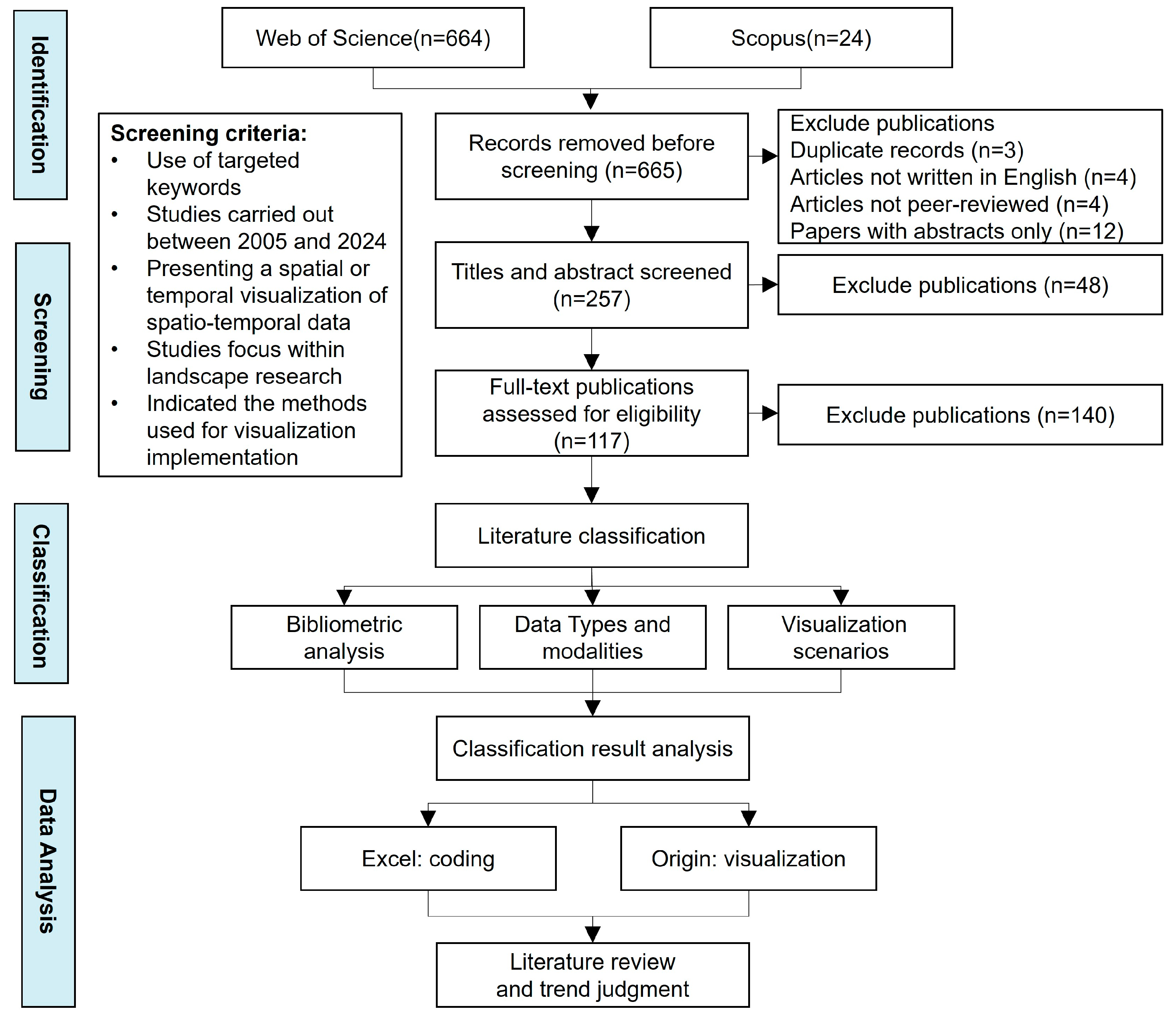
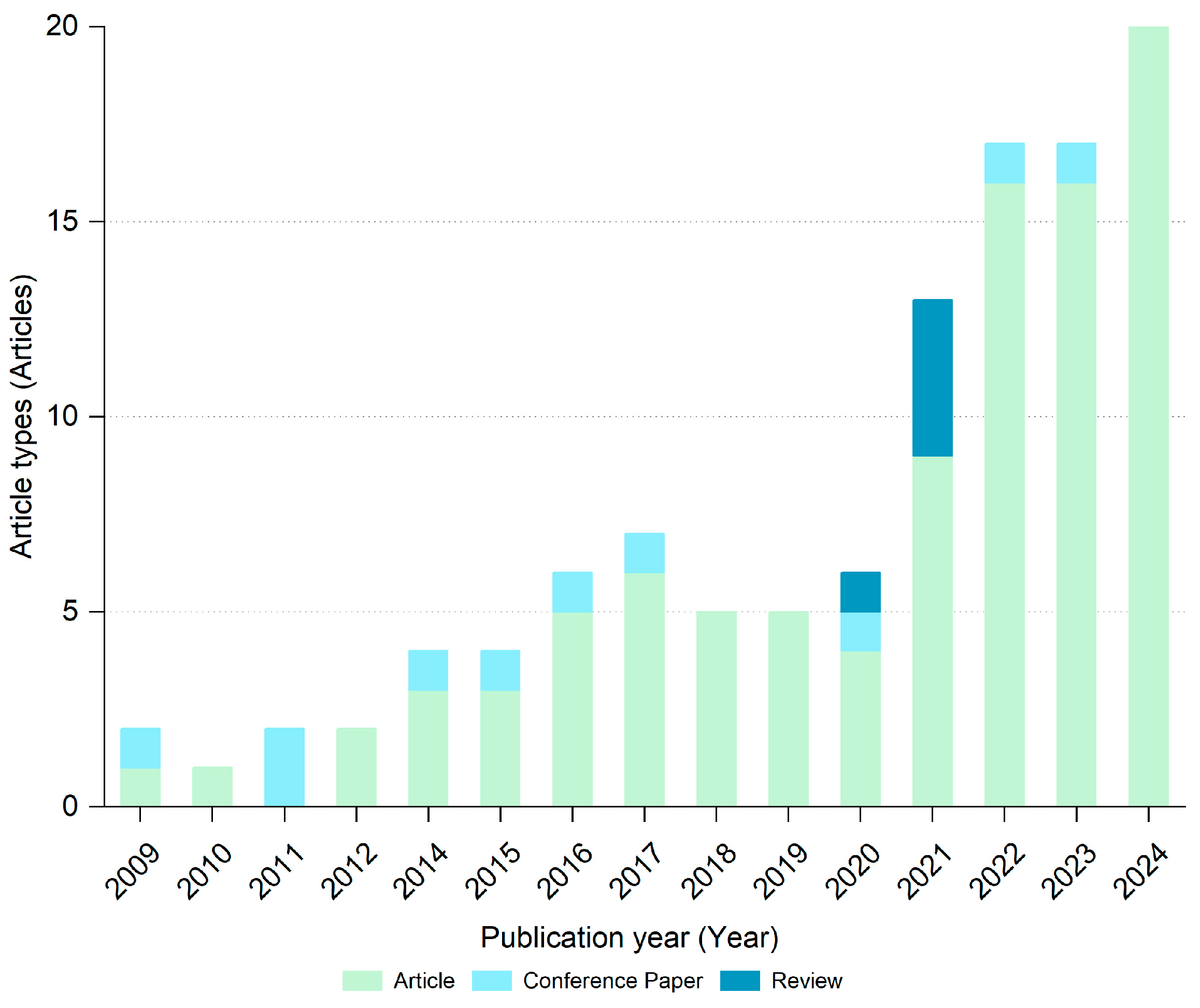
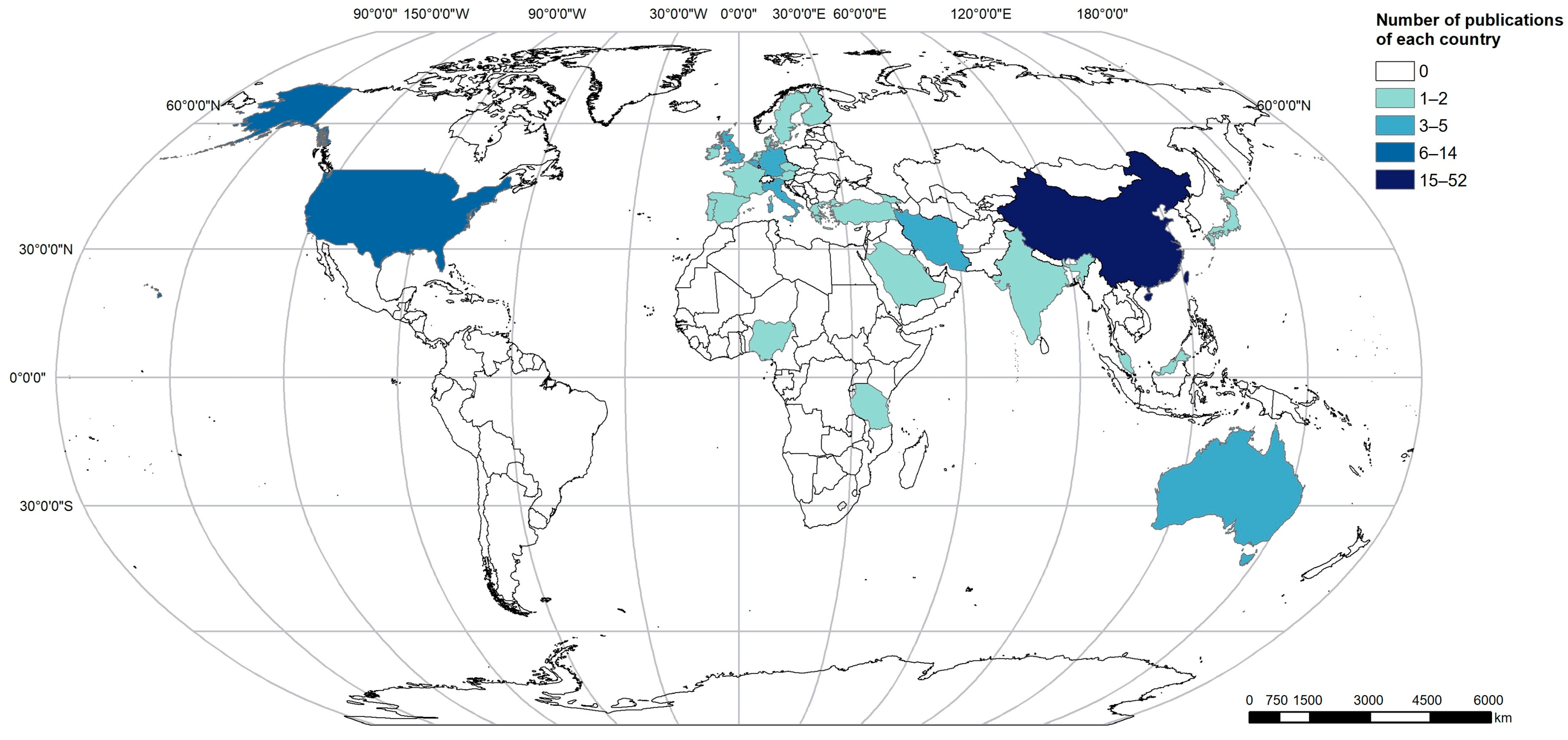
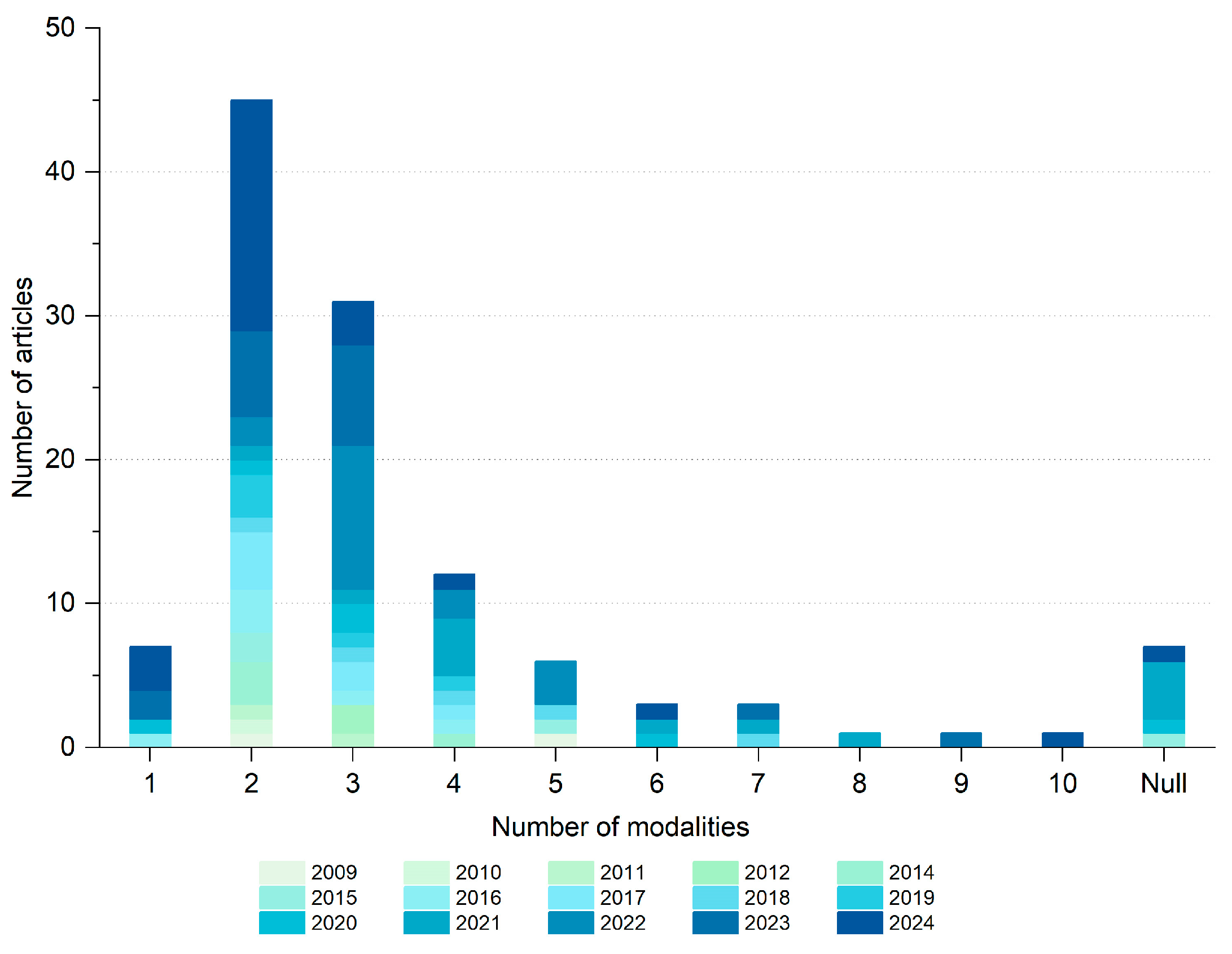
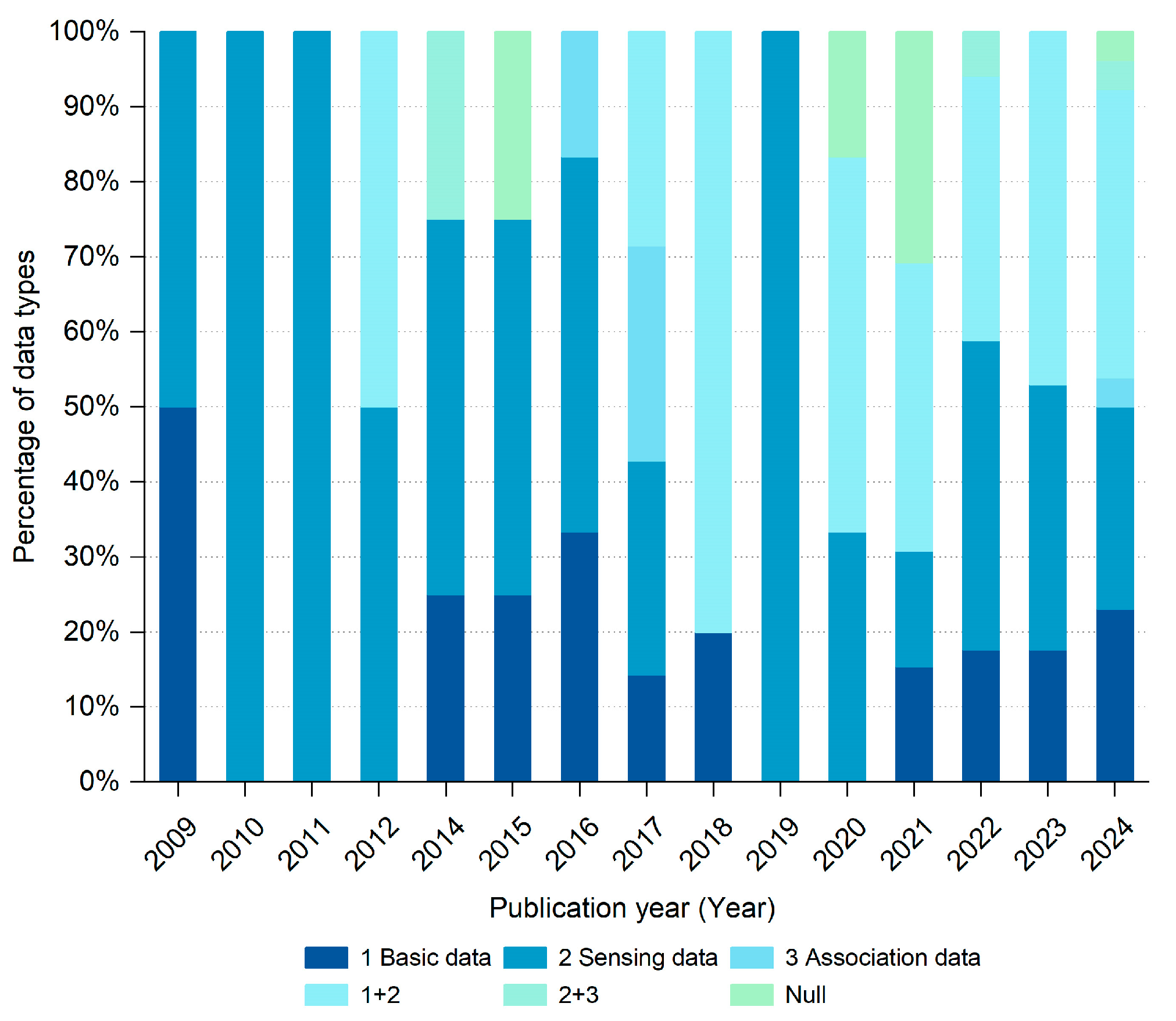
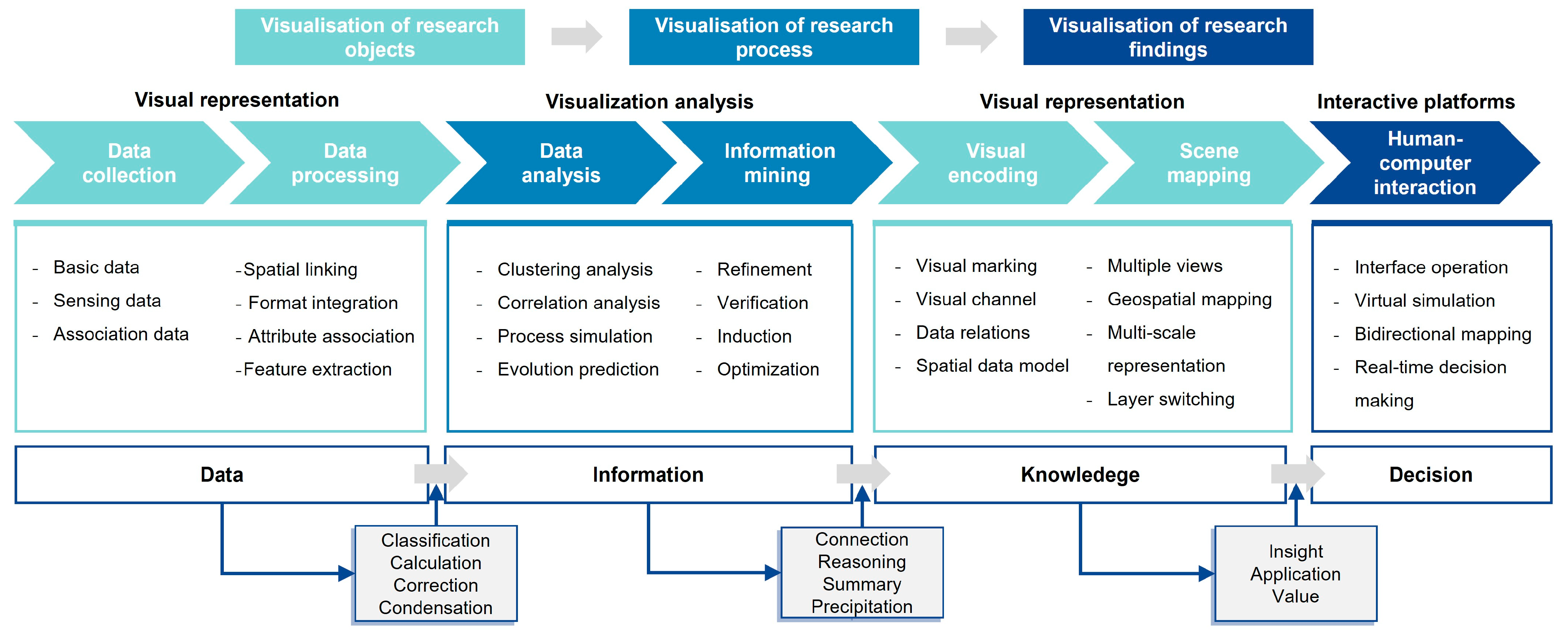
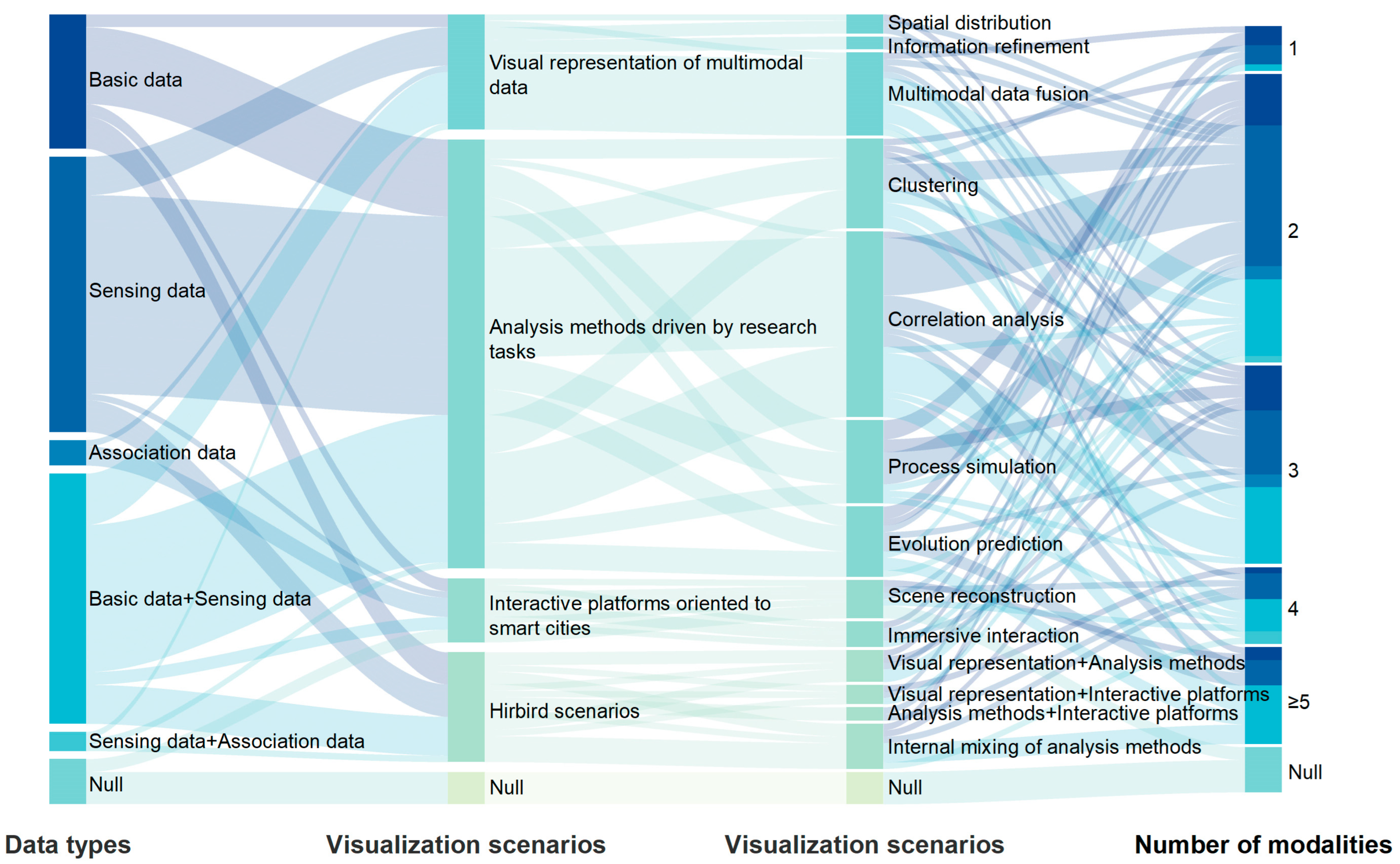
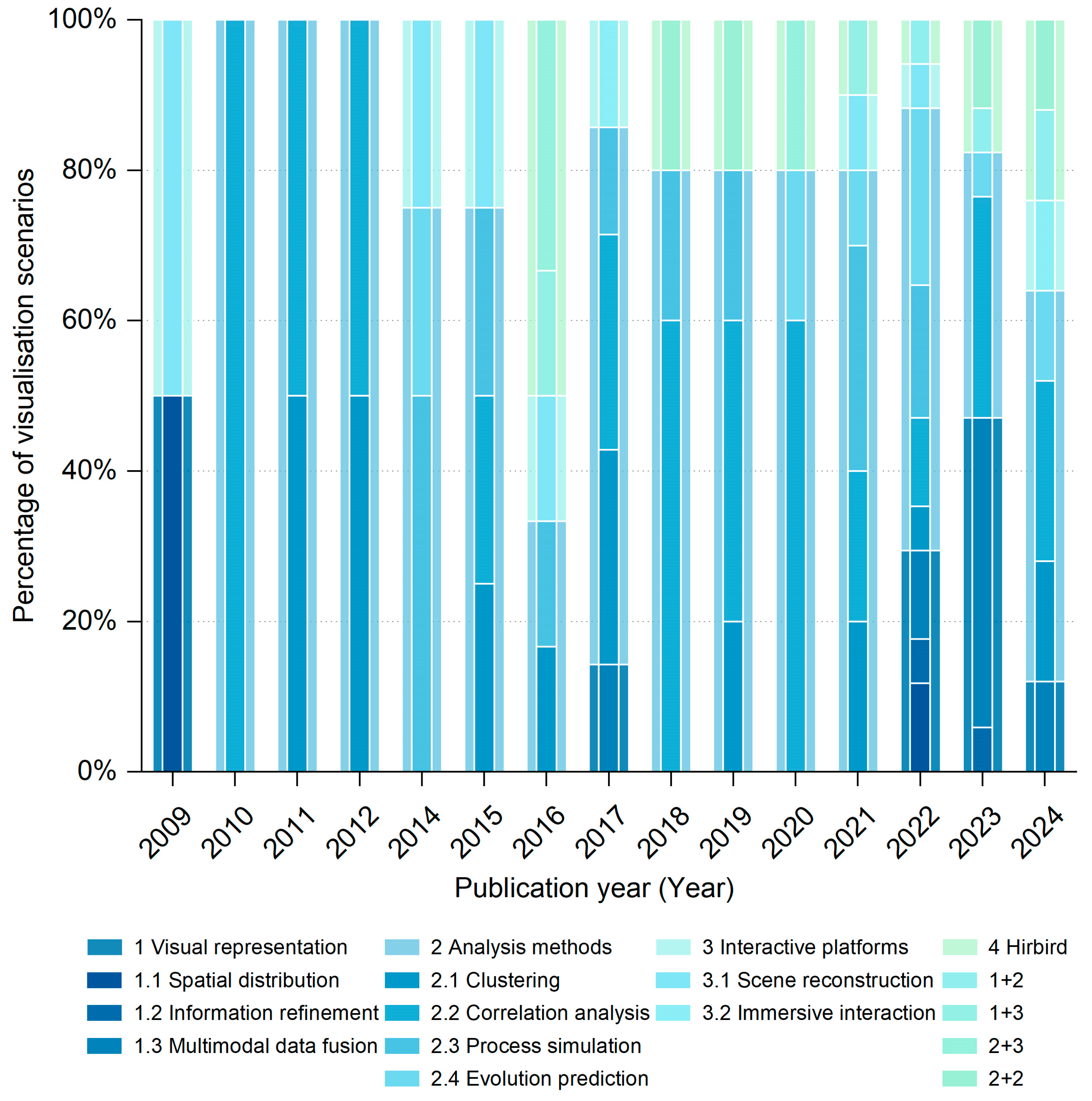
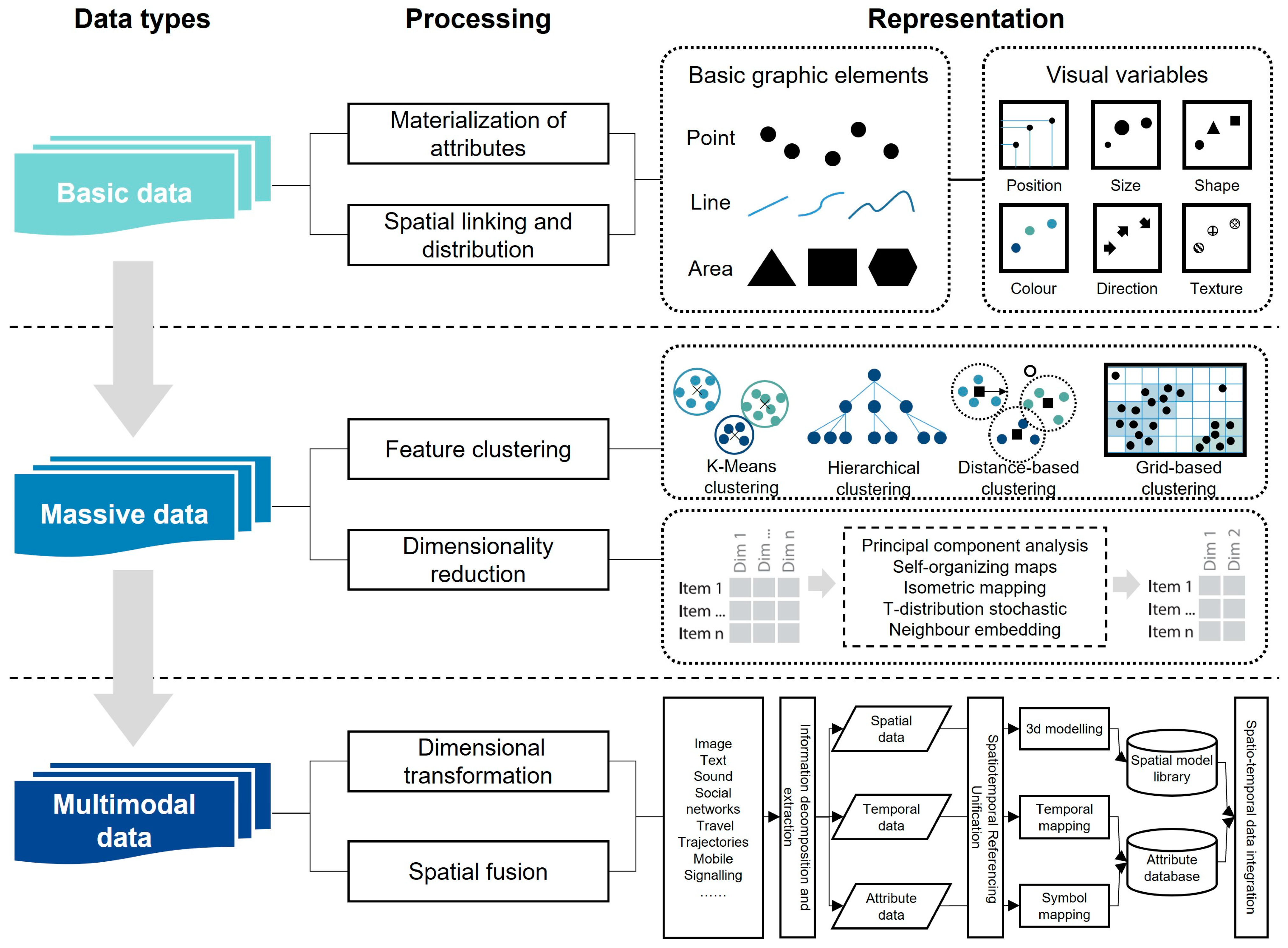
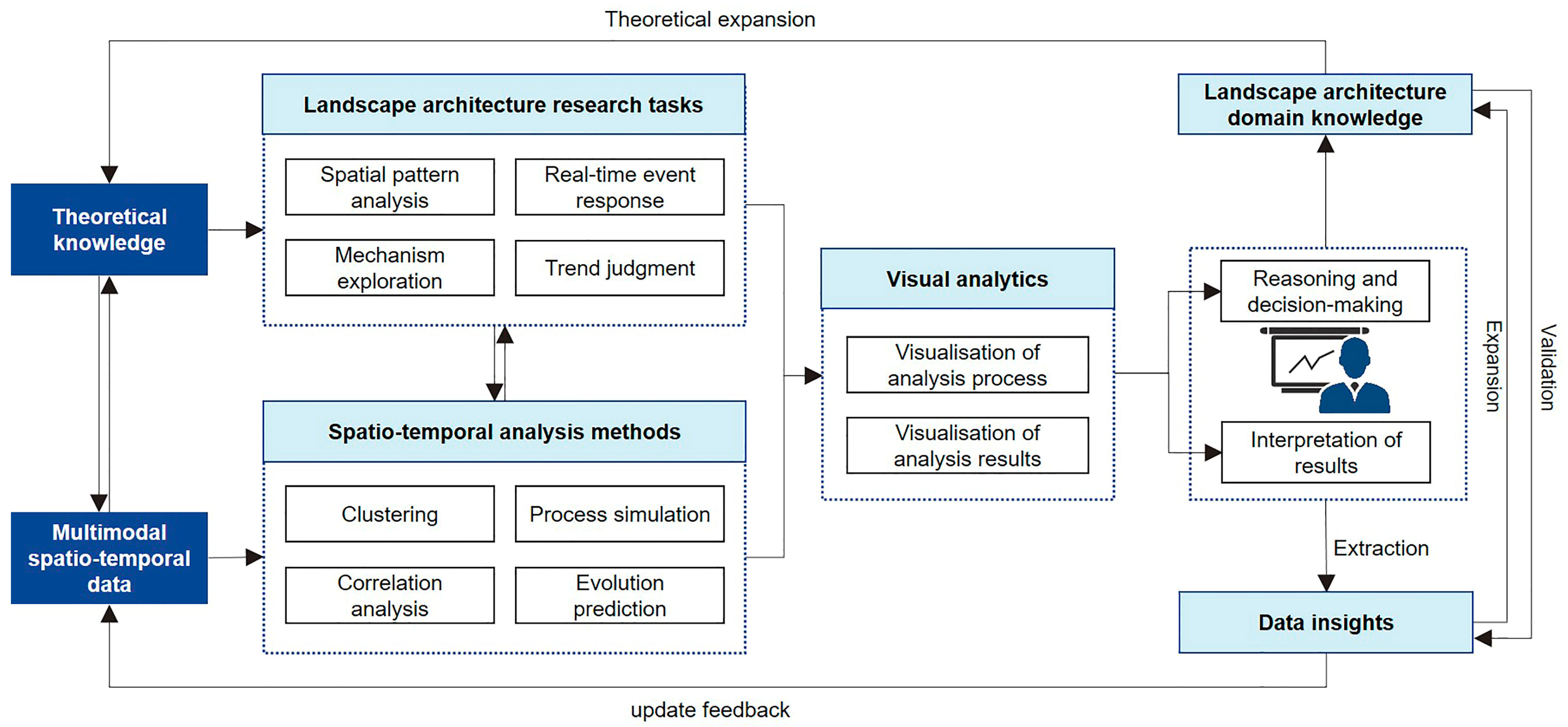

| Review Items | Assessment Criteria | |
|---|---|---|
| Keywords | Multimodal spatio-temporal data | |
| Visualization OR Visual analysis OR Mapping | ||
| Landscape OR Urban | ||
| Journal and article | Journal’s discipline | Architecture or Urban Studies or Regional Urban Planning or Environmental Studies or Green Sustainable Science Technology or Geography or Multidisciplinary Sciences |
| Time span | 1 January 2005 to 31 December 2024 | |
| Document type | Journal article, review, conference paper | |
| Publication language | English | |
| Screening | Exclusion criteria | Articles not written in English Articles not peer-reviewed Articles with abstracts only Articles focused solely on urban planning, architectural engineering, or technical advancements unrelated to landscape architecture |
| Inclusion criteria | Use of targeted keywords Studies carried out between 2005 and 2024 Presenting a spatial or temporal visualization of spatio-temporal data Studies focus within landscape research Indicated the methods used for visualization implementation | |
| Classification | Data Characteristics | Subcategories | Sub-Subcategories | References |
|---|---|---|---|---|
| Basic data | Large-scale, small changes, slow updates | 2D spatial data | Orthographic imagery data, crowdsourced geographic data, etc. | [38,39] |
| 3D spatial data | Digital terrain data, realistic 3D models, artificial modelling data, etc. | [40,41] | ||
| Attribute data | Landscape resources, site facilities, socioeconomic data, etc. | [42,43] | ||
| Abstracted symbol | Control boundaries, points/areas of interest, text labels, etc. | [44,45] | ||
| Sensing data | Strong spatio-temporal sequence, large data scale, fast update speed | Environmental monitoring/simulation data | Meteorological data, soil data, hydrological data, vegetation data, light data, etc. | [46,47,48] |
| Human behavioral monitoring/simulation data | Mobile signaling, trajectory data, activity behavior, etc. | [49,50] | ||
| Human subjective perception data | Social media reviews, multimedia acquisition data, etc. | [51,52] | ||
| Association data | High dimensionality, dynamicity, and complexity | Spatial relation | Spatial coordinates, spatial proximity, spatial topology, etc. | [53,54] |
| Temporal relation | Time points, time intervals, time series, etc. | [41,55] | ||
| Spatio-temporal association | Spatio-temporal locations, spatio-temporal events, spatio-temporal models, etc. | [56] | ||
| Network association | Network topology, network attributes, network dynamics, etc. | [57,58] |
Disclaimer/Publisher’s Note: The statements, opinions and data contained in all publications are solely those of the individual author(s) and contributor(s) and not of MDPI and/or the editor(s). MDPI and/or the editor(s) disclaim responsibility for any injury to people or property resulting from any ideas, methods, instructions or products referred to in the content. |
© 2025 by the authors. Licensee MDPI, Basel, Switzerland. This article is an open access article distributed under the terms and conditions of the Creative Commons Attribution (CC BY) license (https://creativecommons.org/licenses/by/4.0/).
Share and Cite
Han, X.; Li, Z.; Cao, H.; Hou, B. Multimodal Spatio-Temporal Data Visualization Technologies for Contemporary Urban Landscape Architecture: A Review and Prospect in the Context of Smart Cities. Land 2025, 14, 1069. https://doi.org/10.3390/land14051069
Han X, Li Z, Cao H, Hou B. Multimodal Spatio-Temporal Data Visualization Technologies for Contemporary Urban Landscape Architecture: A Review and Prospect in the Context of Smart Cities. Land. 2025; 14(5):1069. https://doi.org/10.3390/land14051069
Chicago/Turabian StyleHan, Xiao, Zhe Li, Hao Cao, and Bingyu Hou. 2025. "Multimodal Spatio-Temporal Data Visualization Technologies for Contemporary Urban Landscape Architecture: A Review and Prospect in the Context of Smart Cities" Land 14, no. 5: 1069. https://doi.org/10.3390/land14051069
APA StyleHan, X., Li, Z., Cao, H., & Hou, B. (2025). Multimodal Spatio-Temporal Data Visualization Technologies for Contemporary Urban Landscape Architecture: A Review and Prospect in the Context of Smart Cities. Land, 14(5), 1069. https://doi.org/10.3390/land14051069







